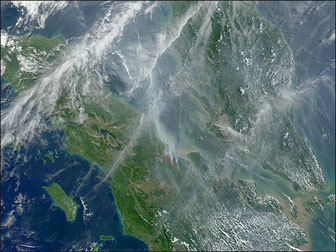Forest fires have high cost to health
Forest fires have high cost to health
mongabay.com
August 10, 2006
Forest fires have a huge impact on human health according to a new study from the University of Alberta in Edmonton, Canada which attempted to put a pricetag on the actual economic losses caused by a 2001 fire that burned 116,000 hectares of forest land and settlements Chisholm, Alberta.
The study, published by researchers from the University of Alberta in the Canadian Journal of Forest Research, “assessed the economic impact of air quality changes arising from forest fires and found that the increases in human health risks were ‘substantial’ in economic terms and were second only to timber losses in terms of dollars and cents,” according to a release from the university.
“The overall health impacts were significant, when compared to other related costs such as fire-fighting,” said Dr. Vic Adamowicz, a professor of rural economy at the University of Alberta and co-author of the study, which estimate that values of health risks from the fire at $9 million and $12 million. Adamowicz says that 95 percent of this amount relates to “increases in mortality risk, restricted activity days, lost wages, and acute respiratory symptoms suffered by those affected by the poorer air quality.”

Haze over Malaysia during fires that took place in the summer of 2001.Image courtesy of the Moderate-resolution Imaging Spectroradiometer (MODIS), flying aboard NASA’s Terra satellite, on July 9, 2001. |
By comparison, the researchers note that other costs related to the fire included “a $2 million loss of bridge infrastructure, losses of 75 buildings including 21 homes… and $1 million attributed to loss of electrical power infrastructure. Fire-fighting costs for the week-long blaze came in at $10 million.” The cost on health effects was only exceeded by the estimated $20 million loss in timber damage.
“Though the costs wouldn’t be as high in every fire, it is interesting to note that even in this case study, only one or two days of the fire generated smoke effects over a large city in the region,” Adamowicz said.
The study comes as concerns mount over the potential for forest fires in Indonesia, which are already burning in some areas. Reuters reports that authorities on the islands of Borneo and Sumatra are preparing for choking “haze” resulting from land-clearing fires in the region. In the past, the haze has caused widespread health effects in neighboring Singapore, Malaysia and Thailand, including heart and respiratory disorders, severe nosebleeds, and eye irritation. While over 200,000 were hospitalized at the time, health officials were concerned for the long-term health effects of prolonged exposure to the air pollution.
REALTED
Forest fires have serious economic, health, and environmental consequences warns FAO
Large forest fires in South-East Asia, notably in Indonesia, have caused serious health and environmental problems, in particular choking haze in the region, FAO said today. “Most of these fires are intentional and planned by agro-industrial companies to clear forests for agricultural land use,” said Mike Jurvelius, FAO forest fire expert.
Haze in Malaysia worsens, may last until October
Malaysia’s Prime Minister declared a state of emergency, closing ports and workplaces and calling on mosque-goers to pray for rain to clear the polluting haze coming from massive forest fires in nearby Indonesia. Meteorologists believe conditions are ripe for the haze to last well into October when rains are next expected.
This article uses quotes from a University of Alberta news release.